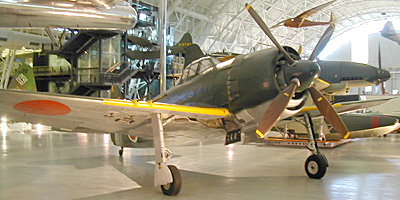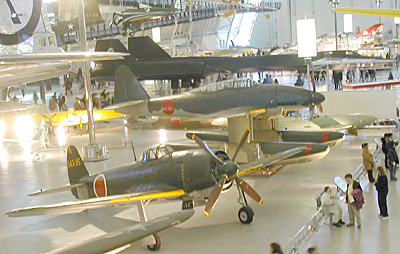
The design Shiden (Violet Lightning) resulted from the realisation of the Kawanishi design team in December 1941 that its N1K1 Kyofu floatplane fighter, which had yet to fly, possessed so much potential that a landplane derivative was clearly a possibility. There followed nine prototypes, the first of them flying in December 1942 at the start of a protracted test programme, before the delivery of 1098 N1K1-J production aircraft in three subvariants differentiated by their armaments. These entered service early in 1944, and were later complemented by 415 examples of the two subvariants of the NIK2-J with a redesigned fuselage and tail unit as well as the wing lowered from the mid- to low-set position allowing the use of shorter main landing gear units. The N1K proved an effective fighter although it was troubled by a temperamental engine.
 "Japanese Row." Well, that's what I call it, anyway. In the foreground, the N1K2 "George", behind which is the Aichi M6A1 Seiran (floatplane). Peeking out from behind that is the Cherry Blossom jet kamikaze, which made its first flight on August 7, 1945.
"Japanese Row." Well, that's what I call it, anyway. In the foreground, the N1K2 "George", behind which is the Aichi M6A1 Seiran (floatplane). Peeking out from behind that is the Cherry Blossom jet kamikaze, which made its first flight on August 7, 1945.
In addition, in the far background, the US SR-71 Blackbird. Behind the SR-71 in the far, far background is the modern jet section, and behind that a view of the hanger doors.
Country of origin: Japan
Type: (N1K1-J) single-seat fighter and fighter-bomber
Powerplant: one 1990hp (1557kW) Nakajima NK9H Homare 21 18-cylinder tworow radial engine
Performance: maximum speed 581 km/h (361 mph); climb to 6000m (19,685ft) in 7 minutes 50 seconds; service ceiling 12,500m (41,010ft); range 2544km (1581 miles)
Weights: empty 2897kg (6387lb); maximum take-off 4321kg (9526lb)
Dimensions: span 12.00m (39ft 4.5in); length 8.88m (29ft 1.88in); height 4.06m (13ft 3.85 in)
Armament: two 20mm fixed forward-firing cannon in the leading edges of the wing, two 20mm fixed forward-firing cannon in underwing gondolas, and two 7.7mm fixed forward-firing machine guns in the forward fuselage, plus an external bomb load of 120kg (265lb)
Specs and description from: Aircraft of WWII by Chris Chant (Fiedman/Fairfax, 1999, ISBN: 1-58663-303-1), a handy book covering 300 aircraft.
WWI
WWII
Japan: Kawanichi N1K2-Ja Shinden Kai (George)
US: Curtiss P40 Tomahawk
Post WWII
US: Northrop N-1M Flying Wing
Other
UHC Displays
Germany: Focke-Wulf FW-190F
Germany: Arado AR-234B
Germany: Junkers JU-52/3m
Germany: Focke-Achgelis FA-330A
Germany: Rheintochter R1 Anti-aircraft Missile (Rhine Maiden)
Japan: Kawasaki Ki-45 Kai Toryu (Nick)
Japan: Aichi M6A1 Seiran
Japan: Kugisho Ohka Model 22 Cherry Blossom
US: Vought F4U Corsair
US: Lockheed P-38J Lightning
US: Boeing B-29 Superfortress "Enola Gay"
US: Grumman F6F Hellcat
US: Republic P-47D Thunderbolt
UK: DeHavilland DHC-1A Chipmunk
US: Lockheed SR-71 Blackbird
US: Space Shuttle "Enterprise"
US: Lockheed Martin X35b Joint Strike Fighter
Back to List of Historic Sites
Back to Travel Master List
Back to MagWeb Master List of Magazines
© Copyright 2004 by Coalition Web, Inc.
This article appears in MagWeb.com (Magazine Web) on the Internet World Wide Web.
Other articles covering military history and related topics are available at http://www.magweb.com